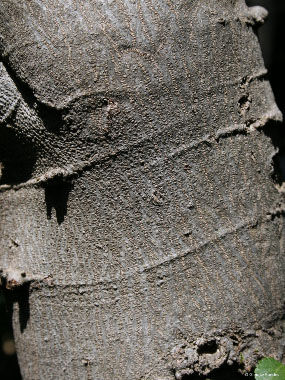






To support our efforts please browse our store (books with medicinal info, etc.).
Crossberry is known as a large shrub or small tree that grows wild in many places throughout Africa. Grewia occidentalis is in the Malvaceae family, and is native to South Africa, Zimbabwe and Mozambique but it can be found as far away as Singapore. Some websites say this grows in Arizona but inevitably this would be cultivated, not wild. This is mostly an evergreen, it may lose some leaves in a cold winter. This shrub copes with severe frost as well as hot, dry, sunny conditions. Crossberry was named for the four-lobed fruits that ripen from January to May. This grows as a scrambling deciduous shrub or small tree.
Trunk/Bark
The bark is somewhat smooth and is light grey to brownish.
Branches/Twigs
Four-angled branches are near the trunk (and have some lenticels); as the branches grow they become round, may droop and trail. Some branches may have some hairs, but these go away at a later stage of growth leaving smooth branches.
Height
Crossberry grows up to 3 meters (9 to 10') in height.
Leaves/Needles
Green leaves grow alternate and are usually symmetric. They are ovate or elliptic with serrulate leaf margin.There are some slight hairs that tend to grown from the veins. Mature leaves reach to 8cm (3.14") long and 4cm (1.57") wide. Leaf veins extend to the leaf margins but often cannot be seen unless the leaf is held up to the light. They are usually shiny dark green.
Flowers
Flowers are individual, lilac, pinkish, mauve, or occasionally white, measuring 3cm (1.18") wide. The flower has 5 petals, and has a 5-lobed calyx. There are many stamens with red filaments. Distinctive yellow anthers contrast nicely with the petal and filament. The flowers usually occur between September and January, but may appear throughout the year.
Fruit
The berries have an unusual shape; four-lobes, initially black, becoming a reddish-brown to light purple when ripe (January to May). If people or birds do not get the drupes, they can remain on the tree for months. The drupe is up to 2.5cm (0.98") wide.
Habitat
Crossberry trees can be found along coastlines, hot and dry locations, woodland forests, grasslands, rocky places, and in coastal dune bush areas.
Edible Parts
The fruit is edible, is said to be quite pleasant when eaten raw.
Other Name
Lavender Star Flower .
Recipes
Winter Survival Food Handbook

PDF Plant Magazines
Types of Wild Food
Geographic Zones Seasons
Disclaimer
EdibleWildFood.com is informational in nature. While we strive to be 100% accurate, it is solely up to the reader to ensure proper plant identification. Some wild plants are poisonous or can have serious adverse health effects.
We are not health professionals, medical doctors, nor are we nutritionists. It is up to the reader to verify nutritional information and health benefits with qualified professionals for all edible plants listed in this web site. Please click here for more information.
Why Edible Wild Food?
- Food costs are rising
- Free, wild food is readily abundant
- Wild food adds nutrition to your diet
- Wild food can help treat various medical conditions





